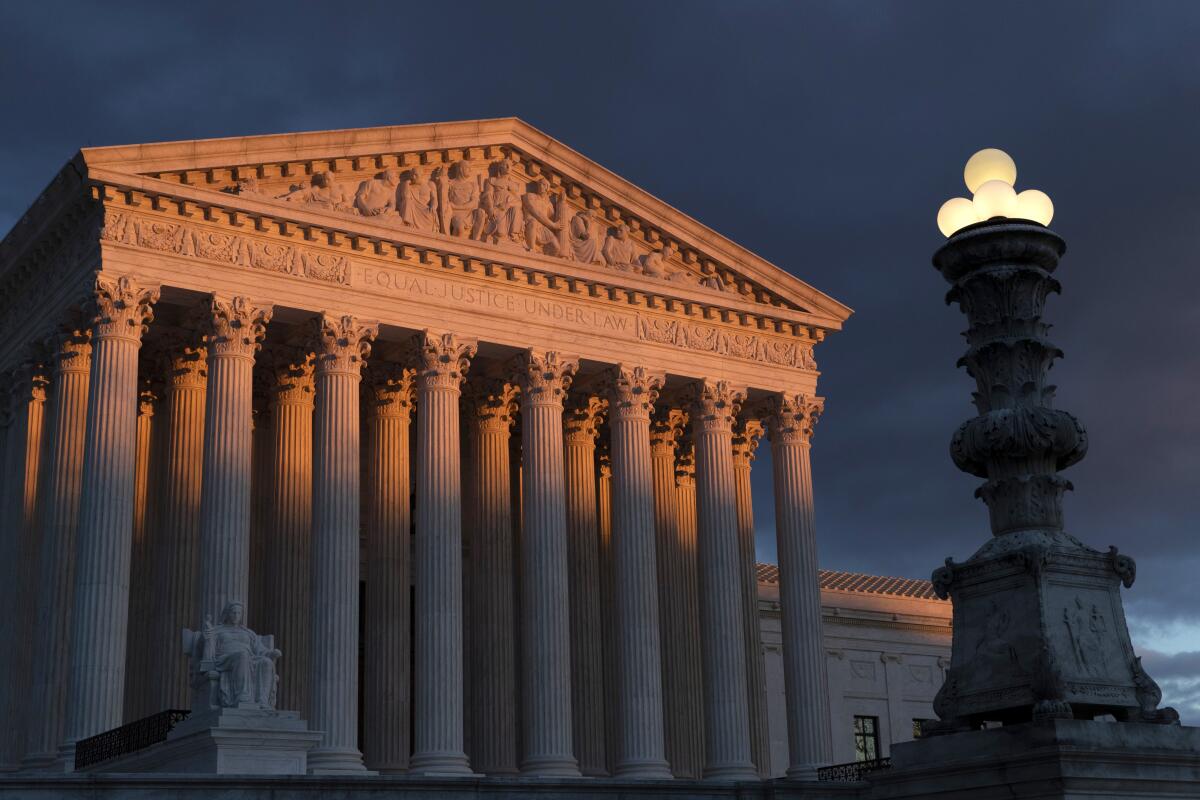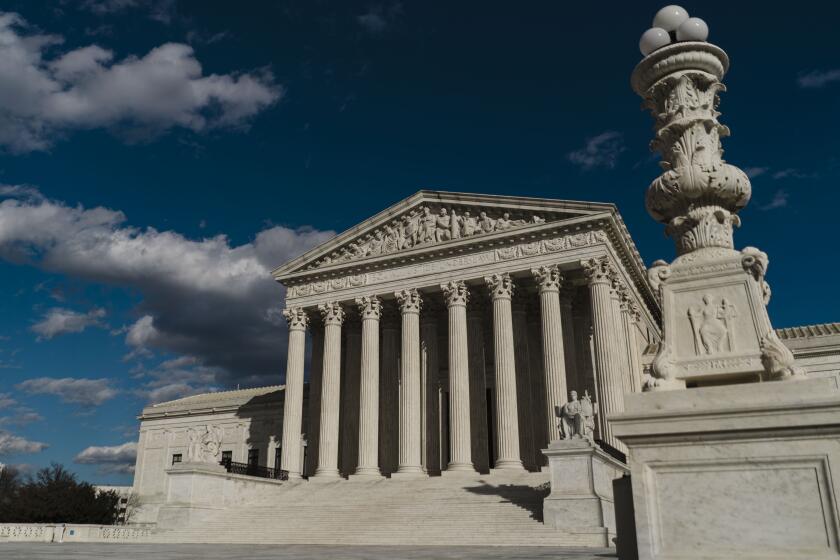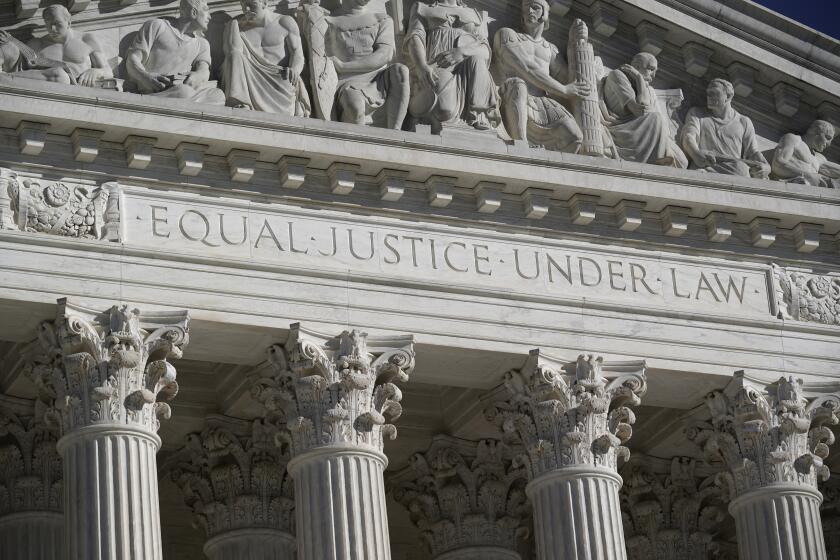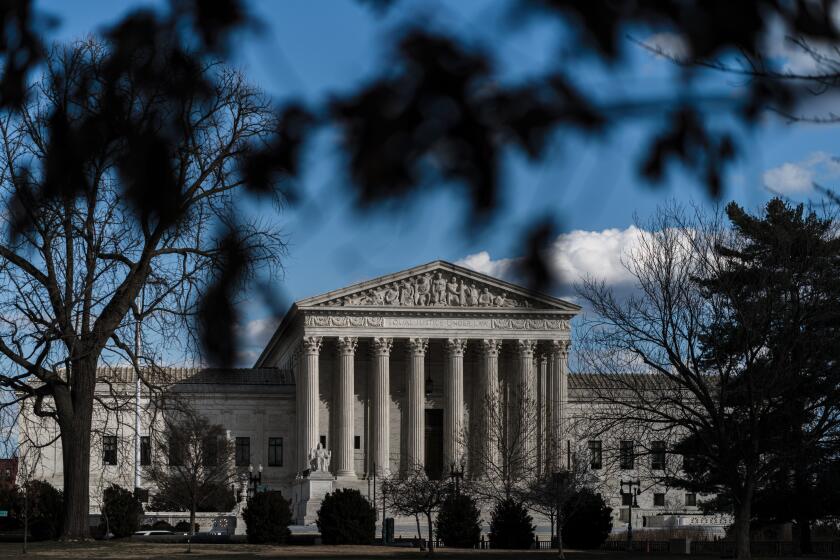Column: The Supreme Court term contained some surprising gifts for Democrats

- Share via
Even a broken clock is right twice a day, as the saying goes. The same lopsidedly right-wing Supreme Court that since June 2022 has overturned longtime precedents to eliminate a federal abortion right, gun controls, clean water safeguards and now affirmative action has also, surprisingly, ruled twice lately to bolster voting rights and fair elections.
More shocking still: One of those decisions, the court’s Allen vs. Milligan ruling early last month, actually gives Democrats a leg up in recapturing control of the House in the 2024 elections.
You read that right. And that landmark ruling is not the only way in which the court, if inadvertently, has potentially benefited Democrats in next year’s elections for the White House and Congress.
Opinion Columnist
Jackie Calmes
Jackie Calmes brings a critical eye to the national political scene. She has decades of experience covering the White House and Congress.
By its 5-4 decision in Allen, with Chief Justice John G. Roberts Jr. and Justice Brett M. Kavanaugh allying with their three liberal colleagues, the court rejected Alabama Republicans’ plea that the justices knock down the surviving pillar of the 1965 Voting Rights Act, which prohibits voting procedures — including legislative maps — that discriminate on the basis of race.
Instead the court upheld the law, and ordered Alabama to redraw its House districts in a way that will mean one district now held by a Republican will be all but certain to elect a Black Democrat.
A similar impact could ripple across the South, to other states where Republicans have gerrymandered maps to limit the influence of Black voters — that is, of Democrats, given the racially polarized voting in the region.
The Supreme Court upholds the reach of the Voting Rights Act, ruling that Alabama must draw an election district that would likely favor a Black Democrat.
Nonpartisan analysts agreed: “The Supreme Court’s New Ruling Could Help Democrats Flip The House In 2024,” was the headline on FiveThirtyEight.com. “A huge win for Democrats,” said the nonpartisan Cook Political Report. Its House analyst, Dave Wasserman, immediately switched the electoral outlook for five districts in Alabama, Louisiana and North Carolina, rating them now as competitive for Democrats. A net loss of five seats would cost Republicans the slim majority they won just last year.
Perhaps Roberts’ and Kavanaugh’s unexpected and decisive votes reflected the outrageous overreach of Alabama Republicans, who seemed emboldened by their otherwise well-placed confidence in the Supreme Court’s Republican-engineered supermajority. They gerrymandered Alabama’s seven House districts to ensure last November’s elections result: six Republican winners, and one Democrat from a single majority-Black district. Now there will be a second majority-Black district, and one fewer favoring Republicans.
By packing so many Black voters in one district and diluting them everywhere else, Alabama had allowed for a group that is more than one-fourth of the state’s population to have a realistic chance at just one-seventh of the state’s House clout.
The decision in Allen vs. Milligan is most significant for what the court didn’t do: It did not further weaken the law of voting rights as many expected.
Louisiana Republicans did much the same in mapping that state’s six House districts; they, too, will probably be forced by the court’s ruling to add a second majority-Black district. Also, the ruling could chill North Carolina Republicans’ plans this year to gerrymander its House districts — now evenly split (like the state’s electorate is generally) with seven Republicans and seven Democrats — to give their party a whopping 11-3 edge.
Given the Allen ruling, it is doubly deplorable that last year the conservative justices had allowed Alabama (and Louisiana) to use contested maps for the midterm elections, the elections that gave Republicans control of the House. Still, with this court progressives just have to adopt a general sense of “it coulda been worse,” and hope for the rare victories.
In that spirit, more on the political bright side: With its Moore vs. Harper ruling last week, the court shot down the so-called independent state legislature theory, the fringe idea that state legislatures can dictate voting and elections laws without fear of check by state courts.
The ‘independent state legislature’ theory is dead. Still, federal lawmakers should take action to ward off other dangers to democracy.
That “theory” took hold among Republicans as seditionist-in-chief Donald Trump tried to reverse his election loss in 2020, and it loomed large for the 2024 elections amid fears the Supreme Court might bless it and grant state legislatures unchecked power over the details of voting.
But common sense and true constitutionalism carried the day, and Democrats in states with extremist Republican legislatures trying to suppress their votes can breathe easier.
Here’s yet another big way — unintended, to be sure — in which the right-wing Supremes have put a thumb on Democrats’ side of the scales for 2024, and not just for House races: By their precedent-defying decisions, particularly in overturning Roe vs. Wade, they have driven the court’s public support to an all-time low, spurring progressive voters to see the court’s makeup as an election issue, much as conservatives did for decades.
The justices are allowing maps selected by each state’s Supreme Court to be in effect for the 2022 elections.
For Democrats, a new rallying cry is — and should be — that the party that controls the White House and the Senate also determines, through judicial nominations and confirmations, which side dominates the judicial branch of government. It worked for Republicans.
The argument is especially potent given that the court’s two most right-wing members are also the oldest: Clarence Thomas, 75, and Samuel Alito, 73. If Republicans were to win the White House and a Senate majority in 2024, either man might decide to retire, confident that like-minded — and much younger — nominees would get their seats, and cement an ultraconservative Supreme Court for decades to come.
For Democrats and progressive voters, it’s time to focus on the legal victories and whatever electoral edge the Supreme Court has provided. Remember: It could be worse.
More to Read
A cure for the common opinion
Get thought-provoking perspectives with our weekly newsletter.
You may occasionally receive promotional content from the Los Angeles Times.
















